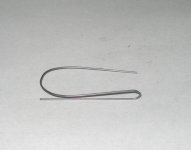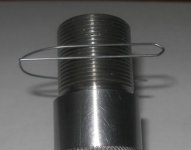Boyd Allen
Active member
Really precise sets of thread measuring wires cost a ton. Cheap sets are not precise but they are affordable. The question that comes to mind is whether I can I come up with a formula to tell me what the over the wires measurement of a given thread would have been with perfect wires, if I know the diameter of my cheap wires.
After some head scratching, and drawing (It has been a long time since plane geometry and trig.) I think that I have an answer.
The correction factor is three times the difference between the wires used and their proper size.
For instance, if my wires measure .0317, .0003 short of perfection (.032) I would need to add three times .0003 to the measurement taken with my wires to get what the measurement would have been with perfect wires. In other words, to calculate the over the wire measurement of any given thread would be with perfect wires, I would have to add .0009 to whatever measurement I get with mine.
With this corrected over over wires diameter I should be able to use the standard constant to calculate pitch diameter, if that is called for.
Added later: All of this is based on a 60 degree V thread.
After looking at many web pages on the subject of the three wire method, I found this one to be the easiest for me to understand. http://littlemachineshop.com/instructions/ThreeWireMethod.pdf
After some head scratching, and drawing (It has been a long time since plane geometry and trig.) I think that I have an answer.
The correction factor is three times the difference between the wires used and their proper size.
For instance, if my wires measure .0317, .0003 short of perfection (.032) I would need to add three times .0003 to the measurement taken with my wires to get what the measurement would have been with perfect wires. In other words, to calculate the over the wire measurement of any given thread would be with perfect wires, I would have to add .0009 to whatever measurement I get with mine.
With this corrected over over wires diameter I should be able to use the standard constant to calculate pitch diameter, if that is called for.
Added later: All of this is based on a 60 degree V thread.
After looking at many web pages on the subject of the three wire method, I found this one to be the easiest for me to understand. http://littlemachineshop.com/instructions/ThreeWireMethod.pdf
Last edited:



